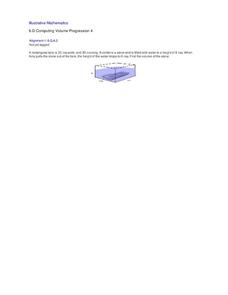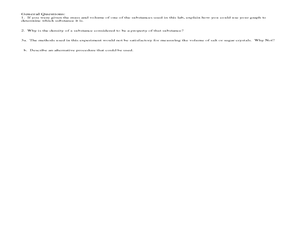American Chemical Society
Finding Volume: The Water Displacement Method
We have formulas for finding the volume of geometric shapes, but what if the shape is irregular? Lesson describes how to find volume through water displacement. After a demonstration, scholars practice in small groups. Then analysis...
Curated OER
Volume Lab
How can we find volume if it a shape isn't easy to measure? Investigate methods for determining this as the volume of regular and irregular objects is explored in several stations. Learners discover that when the standard formula for...
Curated OER
Volume by Water Displacement
In this measuring volume worksheet, students are given 2 diagrams for 24 problems. In the first diagram they are given a graduated cylinder with an initial volume of water. In the second diagram they are give a graduated cylinder with an...
Curated OER
Displacement of Water
To calculate the volume of a stopper by using the method of water displacement., students work with a web animation. They observe the method and then click a button to gather information about the calculations for the stopper dropped in...
Illustrative Mathematics
Computing Volume Progression 4
This resource was written for the younger math learner, but finding the volume of an irregular solid is also a problem for algebra and geometry students. Based on Archimedes’ Principle, one can calculate the volume of a stone by...
Curated OER
Displacement and Density
High schoolers explore displacement. In this displacement and density lesson, pupils find the volume of irregular shaped objects. Afterward, they determine the volume of containers. They compute the amount of water displacement.
Curated OER
Water Displacement to Determine Volume
Sixth graders explore the water displacement method to determine the volume of solid objects such as rocks, nails, and marbles.
Curated OER
MEASURING THE DENSITY OF WATER
Learners perform an experiment to measure the density of tap water vs. salt water.
Curated OER
Volume
In this volume lab instructional activity, students are guided through an experiment to determine volume of a liquid. Students determine water displacement. Students use a formula to calculate volume of a solid figure.
Balanced Assessment
Bathtub Graph
Represent the relationship between independent and dependent variables through a modeling situation. The activity expects learners to graph the volume of water in a bathtub during a given scenario. The graph should result in two areas of...
Curated OER
Chemistry Lab-Molar Volume of Gas
Students determine the molar volume of hydrogen gas. In this molar volume lesson plan, students find the molar volume of hydrogen produced in a reaction between magnesium and hydrochloric acid. They use a eudiometer to measure the volume...
Cornell University
Buoyancy
Swimmers know to float by turning their bodies horizontally rather than vertically, but why does that make a difference? In an interesting lesson, scholars explore buoyancy and the properties of air and water. They test cups to see which...
Santa Monica College
The Density of Liquids and Solids
There are underwater rivers that flow on the ocean floor thanks to a difference in density. Scholars learn about the density in both liquids and solids in the second instructional activity of an 11-part series. They then determine the...
Curated OER
Move that Tower
Students investigate ways to find the density of irregular shaped objects. In this physics lesson plan, students calculate density using its mass and volume. They explain why some objects float or sink in water.
Curated OER
Turn Up the Volume
Measuring volume can be a mystery for 5th graders, but this hands-on activity gives the gift of discovery. The volume of simple rectangular solids and irregular shapes are calculated through various methods including displacing liquid in...
Teach Engineering
Density Column Lab - Part 1
Mass and density — aren't they the same thing? This activity has groups use balance beams and water displacement to measure several objects. The pupils use the measurements to calculate the density of the objects.
NASA
The NBL Pool
That is a lot of water. Class groups explore the size of the NASA's Neutral Buoyancy Pool and calculate the volume of water needed to fill it. They then compare that volume to the amount of water needed to fill a pool the size of a...
Curated OER
Volume of Irregular Objects
Fifth graders experiment using a Meniscus. In this volume lesson, 5th graders identify the volume of irregular objects using the process of water displacement. Students record data and draw conclusions.
Curated OER
Measuring Matter
Explore various types of measurement with fourth graders. They will practice using balance pans to measure the weight of a coin and a graduated cylinder to determine the displacement volume for a bolt. The metric system will be the focus...
Curated OER
Mass and Density of an Irregular Solid
In this physics worksheet, students determine the density of irregular solids using water displacement method to complete 7 problems and short answer questions.
Curated OER
Displacement of fluids
Students understand the meaning of volume. In this displacement of liquid instructional activity, students experiment with various weights and a balance scale to find the liquid displaced.
Curated OER
Density And Volume
Sixth graders explore the concept of density as a relationship of an object's mass to its volume. Densities of a variety of objects are compared and used to identify an unknown object.
Teach Engineering
Determining Densities
Don't be dense—use a robust resource. The second installment of a five-part Floaters and Sinkers unit has learners determine the densities of several objects. As part of the activity, they learn the displacement method for finding...
Teach Engineering
Floaters and Sinkers
Whatever floats your boat. Young engineers learn about density by measuring the masses and volumes of boxes filled with different materials. Using their knowledge of densities, they hypothesize whether objects with given densities will...

























